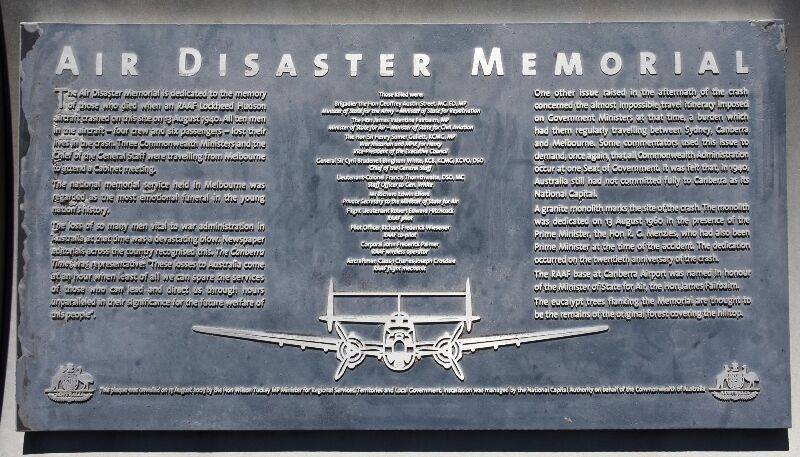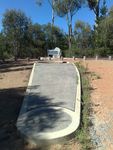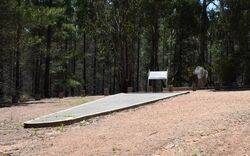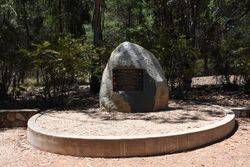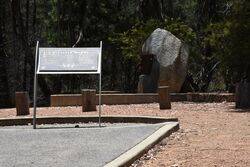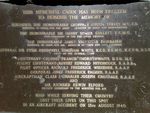
Air Disaster MemorialPrint Page 
The cairn commemorates ten people, including three Commonwealth Ministers and the Chief of the General Staff, who were killed in 1940 when their Royal Australian Air Force Lockheed Hudson crashed while circling prior to landing at Fairbairn Airport. The cairn was completed in 1958 and officially dedicated in 1960.
The original plaque has been replaced on several occasions because of theft or vandalism.
An interpretive plaque and concrete traffic island were unveiled in the presence of the Honourable Wilson Tuckey MP, Minister for Regional Services, Territories and Local Government, on 13 August 2003, the anniversary of the crash. The traffic island footprint was intended to be evocative of an aircraft wing. It replaced an earlier traffic island. The concrete kerb around the monolith appears to have been replaced before this time.
The plane was bringing the Ministers and high officials from Melbourne in 1940 for an important cabinet meeting when it nose dived into the hill and subsequently burst into flames. The tragedy assumed the proportions of a national disaster in view of the loss of the chief administrators of Australia`s war effort.
A memorial was suggested in Parliament by Dr Maloney (Labor) on 14 August 1940. However it was not until Dame Annabelle Rankin wrote to the then Minister for Air, William McMahon, about the request by Sir Brundenell White`s relatives that a small cairn be erected at the point of the crash in memory of those who lost their lives, that the suggestion was given serious consideration.
The request, in January 1952, was referred to Prime Minister Robert Menzies, who was Chair of the National Memorials Committee and very supportive of the project.
Location
| Address: | Pialligo Avenue, Fairbairn Pine Plantation, Majura, 2609 |
|---|---|
| State: | ACT |
| Area: | AUS |
| GPS Coordinates: | Lat: -35.318444 Long: 149.229306 Note: GPS Coordinates are approximate. |
Details
| Monument Type: | Monument |
|---|---|
| Monument Theme: | Disaster |
| Sub-Theme: | Aviation |
| Actual Event Start Date: | 13-August-1940 |
| Actual Event End Date: | 13-August-1940 |
Dedication
| Actual Monument Dedication Date: | Saturday 13th August, 1960 |
|---|
THIS MEMORIAL CAIRN HAS BEEN ERECTED
TO HONOUR THE MEMORY OF
Brigadier the Honourable Geoffrey Austin Street, M.C., E.D.
Minister of State for the Army : Minister of State for Repatriation
The Honourable Sir Henry Somer Gullett, K.C.M.G.
Vice - President of the Executive Council
The Honourable James Valentine Fairbairn
Minister of State for Air : Minister of State for Civil Aviation
General Sir Cyril Brudenell Bingham White, K.C.B., K.C.M.G.,
K.C.V.O., D.S.O.
Chief of the General Staff
Lieutenant - Colonel Francis Thornthwaite, D.S.O., M.C.
Flight Lieutenant Robert Edward Hitchcock, R.A.A.F.
Pilot Officer Richard Frederick Wiesener, R.A.A.F.
Corporal John Frederick Palmer, R.A.A.F.
Aircraftsman Class 1 Charles Joseph Crosdale, R.A.A.F.
And
Mr. Richard Edwin Elford
Private Secretary To The Minister For Air
Who While Serving Their Country
Lost Their Lives On This Spot
In An Aircraft Accident On 13th August 1940.
AIR DISASTER MEMORIAL
The Air Disaster Memorial is dedicated to the memory of those who died when an RAAF Lockheed Hudson aircraft crashed on this site on 13th August 1940. All ten men in the aircraft - four crew and six passengers - lost their lives in the crash. Three Commonwealth Ministers and the Chief of the General Staff were travelling from Melbourne to attend a Cabinet meeting.
The national memorial service held in Melbourne was regarded as the most emotional funeral in the young nation`s history.
The loss of so many men vital to war administration in Australia at the time was a devastating blow. Newspaper editorials across the country recognised this. The Canberra Times was representative : "These losses to Australia come at an hour when least of all we can spare the services of those who can lead and direct us through hours unparralled in their significance for the future welfare of this people."
Those killed were :
Brigadier the Hon Geoffrey Austin Street, MC, ED, MP
Minister of State for the Army - Minister of State for Repatriation
The Hon James Valentine Fairbairn, MP
Minister of State for Air - Minister of State for Civil Aviation
The Hon Sir Henry Somer Gullett, KCMG,
War historian and MHR for Henty
Vice - President of the Executive Council
General Sir Cyril Brudenell Bingham White, KCB, KCMG, KCVO, DSO
Chief of the General Staff
Lieutenant - Colonel Francis Thornthwaite, DSO, MC
Staff Officer to Gen. White
Mr. Richard Edwin Elford
Private Secretary to the Minister of State for Air
Flight Lieutenant Robert Edward Hitchcock, RAAF Pilot
Pilot Officer Richard Frederick Wiesener, RAAF Co-pilot
Corporal John Frederick Palmer, RAAF Wireless Operator
Aircraftsman Class 1 Charles Joseph Crosdale, RAAF Flight Mechanic
One other issue raised in the aftermath of the crash concerned the almost impossible travel itinerary imposed on Government Ministers at that time, a burden which had them regularly travelling between Sydney, Canberra and Melbourne. Some commentators used this issue to demand, once again, that all Commonwealth Administration occur at one Seat of Government. It was felt that, in 1940, Australia still had not committed fully to Canberra as its National Capital.
A granite monolith marks the site of the crash. The monolith was dedicated on 13 August 1960 in the presence of the Prime Minister, the Hon. R. G. Menzies, who had also been Prime Minister at the time of the accident. The dedication occurred on the twentieth anniversary of the crash.


